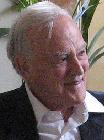

Roy McWeeny

Born May 19, 1924 in Bradford, Yorkshire, England.
Professore Emerito Ordinario di Chimica Teorica, Dipartimento di Chimica e Chimica Industriale dell'Università, Pisa, Italy.
Email:mcweeny@dcci.unipi.it
Member International Academy of Quantum Molecular Science. Member European Academy of Arts, Sciences and the Humanities.
Author of:
Symmetry: An Introduction to Group Theory (Pergamon, Oxford, 1963); Methods of Molecular Quantum Mechanics (with B.T. Sutcliffe) (Academic, London 1969); Spins in Chemistry (Academic, New York, 1970); Quantum Mechanics: Principles and Formalism (Pergamon, Oxford, 1973); Quantum Mechanics: Methods and Basic Applications (Pergamon, Oxford, 1973); Coulson's Valence (Oxford University Press, 1979); Methods of Molecular Quantum Mechanics, 2nd Ed (Academic, London, 1989); with many chapters in multi-author volumes and about 150 research publications.
Important Contributions:
- Calculation of wavefunctions in momentum space; use of gaussian approximations; theory of Compton scattering.
- Theory of X-ray scattering by bonded atoms; scattering factor calculations with gaussian approximation of Slater orbitals; partitioning of electron density using atom and bond populations; calculation of diamagnetic properties of aromatic systems.
- Ab initio VB theory with orthogonalised orbitals; general theory of orbital approximations, electron density and use of reduced density matrices; formulation of master equations for MCSCF calculations.
- SCF theory with direct (steepest descent) calculation of the Fock-Dirac density matrix; electronic properties of p-electron systems (ring currents, NMR shielding, electronic spectra).
- Introduction of 'group-function' theory for description of large molecules; general theory of charge and spin densities and origin of electronic properties, spin Hamiltonians, etc.; first applications of Hall-Roothaan SCF equations to crystals.
- SCF perturbation theory for the Fock-Dirac density; applications to electric and magnetic properties.
- Semi-empirical schemes for large-molecule calculations; techniques for MCSCF calculations; extensions of the Koopmans theorem.
- Theory of spin-orbit splitting and g tensors; use of pseudo potentials in valence-electron-only calculations; many-shell SCF theory in photo-electron spectroscopy.
- Time-dependent Hartree-Fock theory for the density matrix; frequency dependent polarizabilities; calculations of dispersion interactions.
- General theory of linear response using multi-configuration TDHF (propagator) methods; applications in intermolecular force calculations; structure of van der Waals complexes.
- Development of new forms of ab initio VB theory, with fully optimised non-orthogonal orbitals; applications to reaction surfaces for bond-breaking processes, ion-molecule reactions, and unusual bonding situations; new techniques for ab initioi calculations on large molecules.
An obituary can be found here.